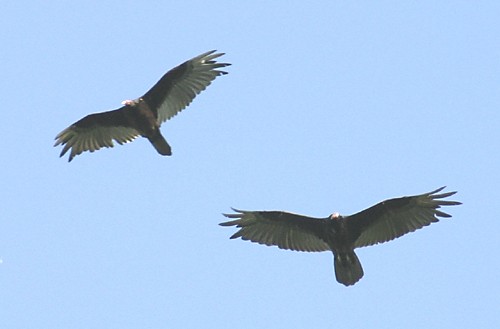
For years, it was believed that all vultures were raptors, members of the order Falconiformes.
In 1994, however, it was discovered that vultures on this side of the Atlantic actually share a common ancestor with storks and ibises. Now, New World vultures are recognized as Ciconiiformes, in the family Cathartidae, while European, African, and Asian vultures are recognized as Old World vultures (family Accipitridae, subfamily Aegypiinae). There are 15 species of Old World Vultures and 7 Species of New World Vultures.
What is a buzzard?
In the U.S. vultures are often called "buzzards," but in actually a buzzard is a European member of the hawk family. The European buzzard, Buteo buteo, is closely related to the American red tailed hawk.
Almost all the vultures you see in the U.S. are Turkey Vultures. Black Vultures also exist in the South, but they do not have the graceful flight of the Turkey Vulture and are not as common. California Condors (a type of vulture) have been retintroduced in California and Arizona, but are so rare you are unlikely to see one in your entire life unless you make a special trip to the remote areas where they have been released.
Turkey Vultures got their name from their bald red heads. The lack of feathers on their head are an adaptive mechanism -- when a vulture is eating a dead animal, it often sticks its head inside the carcass to reach the meat. Feathers on the head would trap unwanted flesh and blood, along with bacteria. A bald head, then, is an adaptive mechanism for cleanliness, as is the vulture's habit of urinating down its own legs -- another way to clean off clinging bits of flesh and bacteria.
Turkey Vultures have few predators, other than man. Their nests are scratched out of bare patches of soil on cliff faces and out of the rotting wood at the tops of broken trees. They will often nest in the sides of abandoned farm buildings as well -- old silos being a favorite location. Vulture nests are subject to predation by raccoons, but the vulture as a fairly effective defensive mechanism -- it vomits up a large masses of semi-digested meat along with very acidic digestive juices. The smell of Turkey Vulture Vomit is rather astounding, and the stomach acid is acidic enough to burn a raccoon's eyes.
You will rarely see Turkey Vulture flying in the early morning, as they launch themselves from trees, cliffs, powerlines, barns and silos only after the morning air has warmed up. A Vulture will fly into a thermal uplift, ride it up in a wide circle, and then glide across the sky at speeds of up to 50 miles per hour gently falling until they reach the next thermal which they in turn ride up again -- repeating the process adinfinitum. On a good day, a Turkey Vulture can glide for four of five hours without flapping its wings.
The feet of a Turkey Vulture are very weak and are built a bit like a chicken's -- they cannot catch small prey like a rabbit. Road kill is their primary food source, and the rise in deer, raccoon, possum and groundhog populations has meant a rise in turkey vultures. Vultures are also common on river banks where they scavenge washed-up fish.
.
No comments:
Post a Comment